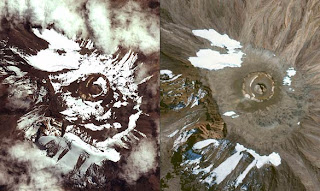Mount Kilimanjaro in June 2001 (left) and July 2009 (right). The satellite images show a vastly decreasing amount of snow
TIMES
Hannah Devlin
The snows of Mount Kilimanjaro will be gone within two decades, according to scientists who say that the rapid melting of its glacier cap over the past century provides dramatic physical evidence of global climate change.
If the forecast — based on 95 years of data tracking the retreat of the Kilimanjaro ice — proves correct it will be the first time in about 12,000 years that the slopes of Africa’s highest mountain have been ice-free.
Since 1912, 85 per cent of the glacier has disappeared and the melting does not appear to be slowing down. Twenty-six per cent of the ice has disappeared since 2000.
The study, published today in the journal Proceedings of the National Academy of Sciences, concludes that the primary cause of the ice loss is the increase in global temperatures. Although changes in cloudiness and snowfall may also play a role, these factors appear to be less important. Even intense droughts, including one lasting about 300 years, did not cause the present degree of melting.
The study, based on terrestrial and satellite photographs, shows the shrinking contours of ice at points between 1912 and 2007. The 12 sq km (4.6 sq miles) of ice coverage in 1912 contracted to 1.9 sq km by 2007, going from two large ice fields to a collection of several smaller, isolated patches.
In a second part of the study, scientists from the Ohio State University drilled down to the rock beneath the ice and extracted cylindrical crosssections, known as ice cores, at six different sites on the glacier. The cores, which were up to 49m (160ft) long, provided a record of the freezing, melting and precipitation patterns of the past 11,700 years.
Elongated bubbles in the surface layer of one of the cores indicated that extensive melting and refreezing had taken place in the past 40 years. In the past even extreme climate events had not led to substantial melting. A severe drought 4,200 years ago lasting three centuries left a 1in dust layer but no evidence of significant melting.
Radioactive dating techniques also showed that the ice was quickly thinning, as well as contracting in area. The Southern Ice Field had thinned by 5.1m between 2000 and 2007, and the smaller Furtwängler Glacier had thinned by 4.8m — 50 per cent of its total depth.
“There will be a year when Furtwängler is present, and, by the next year, it will have disappeared,” Lonnie Thompson, a paleoclimatologist at Ohio State University who led the study, said.
The melting of Kilimanjaro is part of a trend of glacial retreat throughout Africa, India and South America. Melting is occurring on Mount Kenya, the Rwenzori Mountains in central Africa, as well as on tropical glaciers high in the Andes andHimalayas.
“The fact that so many glaciers throughout the tropics and subtropics are showing similar responses suggests an underlying common cause,” Professor Thompson said.
He attributed the changes to increases in the Earth’s surface temperatures, which are exaggerated at high altitudes. Scientists predict that, even if no further significant warming occurs, all but the very highest of summits will eventually melt.
The melting of glaciers can be devastating for species who rely on snowy environments for survival. It can also have consequences for agriculture. Much of the river flow in glacial regions comes from melt water and glacial retreat is predicted to increase water scarcity.
The Met Office predicted this month that glacial retreats could lead to a 20 per cent decline in global agricultural productivity.

No hay comentarios:
Publicar un comentario